How to make the perfect spring rolls
These crisp, golden packages are the perfect dish to celebrate Chinese New Year, but what should you use to fill them? And is a deep or shallow fry the answer to the crunchiest bite?
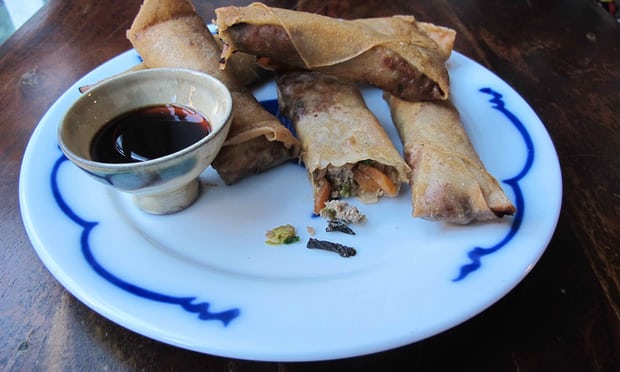
Perfect spring rolls by Felicity Cloake. Photograph: Felicity Cloake for the Guardian
For those celebrating Chinese New Year this month, the spring roll – hot, crisp and crammed full of vegetables – is a festive essential; a symbol of prosperity to come, thanks to their similarity to gold bars. To be honest, as much as I love the idea of gorging myself on ingots, it has been a while since I got excited about a spring roll: the unloved staple of the flabby supermarket "oriental selection", sad companion of the battered saveloys at the chippie, heavy on the bean sprouts, yet tasting of nothing but grease, it is not a treat that has travelled well.
Although spring rolls certainly aren't confined to China – almost every country in east Asia has its own version – here, for reasons of space, I'll be sticking to the Chinese sort, but I suspect at least some of the information might prove useful when making Vietnamese chả giò, Filipino lumpia or Thai po pia tod as well. If you happen to know a restaurant that does one of these well, makes them from scratch and cooks them to order, then gold bars or not, you are wealthy indeed. The rest of us, however, are best off making our own: whatever the year of the rooster has in store for us, you won't regret it.
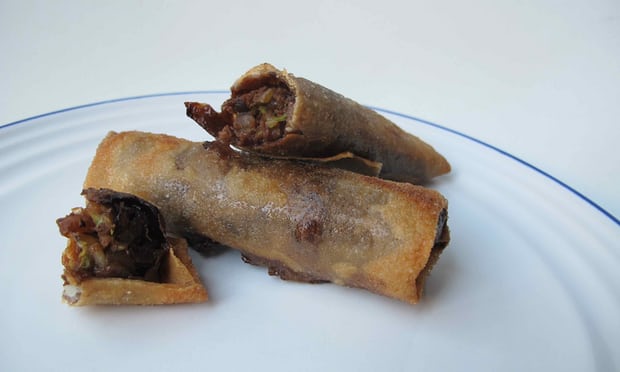
Ken Hom's spring rolls – he opts for shop-bought wrappers. Photograph: Felicity Cloake for the Guardian
The pastry
Chinese spring rolls come wrapped in a thin, slightly elastic pastry not dissimilar to filo. To my relief, Ken Hom – a man who might know a thing or two about authentic Chinese cookery given his royal recognition in the form of an OBE "for services to culinary arts" – reassures readers of his book The Taste of China that spring roll "wrappers are rarely homemade but purchased at a local store".
But, of course, there is always someone who insists on doing things the hard way, and here that person is Fuchsia Dunlop, another authority on the subject, who – though she admits in her Revolutionary Chinese Cook Book that "spring roll wrappers can be bought frozen in many Oriental supermarkets" – is of the opinion these lack "the delicate crispness of the homemade variety". Thankfully, she is kind enough to warn me that making them yourself is, however, "a tricky business", because, as she predicts, my first attempt does indeed "end up with something resembling the Quatermass experiment". The dough itself isn't the problem (but it is wet enough to be tricky to work with) – it's turning it into wafer-thin pancakes that proves well-nigh impossible. Mine is, I think, slightly too thick, which makes it hard to spread on to the hot pan – certainly my few successes are rather thicker than I think Dunlop intended, even though they taste pretty good.
The frozen spring roll wrappers are somewhat easier to come by: I find them at a tiny Oriental grocers locally. They are also considerably easier to manipulate, so, unless you're a masochist, I would recommend letting someone else do the hard work for you.
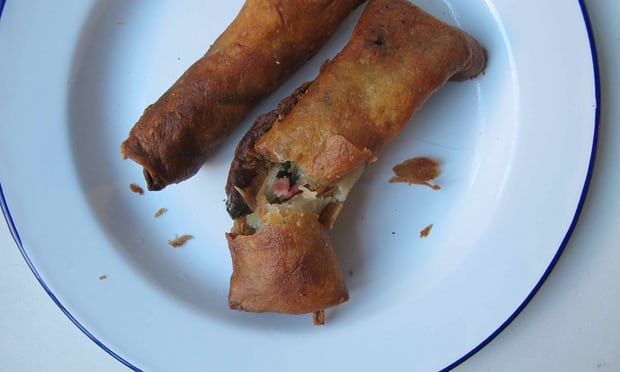
Fuchsia Dunlop's spring rolls: making wrappers is a tricky business. Photograph: Felicity Cloake for the Guardian
The vegetables
Spring rolls are traditionally a vegetable-heavy dish, although fillings vary by region and can include seafood, tofu, even a sweet red bean paste, but the most common kind seems to involve vegetables, usually a combination of vegetables and meat. Only one of the recipes I try eschews meat altogether, though: Helen and Lisa Tse's book A Chinese Street Food Odyssey notes that their vegetarian version is their dad's favourite (but "Mum likes chicken. Such is life"). Instead, they are packed full of bean sprouts, carrots, bamboo shoots and mushrooms.
Cabbage is also popular, with Hom blanching it before use, Julie and Amy Zhang braising it in The Dumpling Sisters Cook Book and Andrea Nguyen stir-frying it in her book, Asian Dumplings (Chinese leaf is often recommended, but the Zhangs suggest white cabbage if that is easier to come by). Nguyen, in a left-field move, also includes celery, while the Zhangs suggest an optional extra of mook yee (cloud ear fungus) if you happen to have some handy.
I don't want to get too prescriptive, as the choice of vegetables should be largely dictated by your own tastes and what is available, but my testers enjoy the sweetness of the Zhangs' carrots, and the textural contrast between soft cabbage and crunchy bamboo shoots and bean sprouts in Dunlop and the Tses'. A base of cabbage or a similarly tender leafy green, topped up with something a little crisper, such as carrots, bean sprouts, water chestnuts or bamboo, would be ideal, and I would highly recommend including some sort of dried mushroom in there, too, especially if you're planning to keep your spring rolls vegetarian. Not only will they add yet another texture to your rolls, but a welcome shot of savoury flavour, as well.
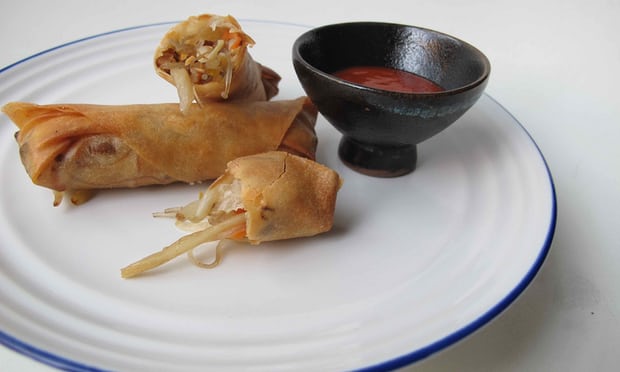
Helen and Lisa Tse's spring rolls: a vegetarian option, though let down by lack of seasoning. Photograph: Felicity Cloake for the Guardian
Meat
My testers are overwhelmingly underwhelmed by the Tses' vegetarian spring rolls, although I suspect that is more down to a lack of seasoning than because they are monstrous meat fiends. Certainly, good spring rolls can be made without any animal products whatsoever and, if you'd like to do so, feel free to swap the pork for thin strips of firm tofu, cooked with the vegetables, or indeed just more vegetables.
Every other recipe I try uses pork, which seems to be by far the most popular choice of meat (if you don't eat pork, you could try it with chicken, duck or seafood). Hom and the Zhangs use minced pork, Nguyen char sui pork roasted with a sweet and salty marinade, and Dunlop smoked bacon. The char sui, although delicious, adds a good few hours to the process, and testers find it a bit dry and chewy once cooked a second time ("I don't really feel like this filling is made for a spring roll," one says, picking it out to eat separately). Dunlop's bacon is pronounced delicious, but the minced pork is the clear favourite, especially Hom's version, which keeps it raw until deep-frying, making his rolls particularly juicy. (It should cook through but, if you're worried, stir-fry it along with the vegetables.)
Extras
Hom also adds minced prawns to his filling, but only one keen-tongued tester picks these up, so I don't think they add much to proceedings. The Tses use mung bean thread noodles, soaked, which I rather like for their slightly chewy, bland starchiness, but the panel isn't keen – "I feel like they're taking up valuable real estate and not adding much," is one comment.
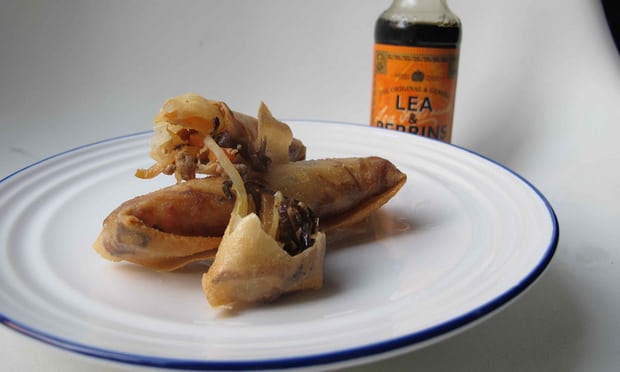
Julie and Amy Zhang's spring rolls: 'I could die on these.' Photograph: Felicity Cloake for the Guardian
Seasoning
Everyone seasons their filling with soy sauce; Hom uses so much of the dark variety his turns inky black and spills through the wrapper, leading me to suspect a vital draining instruction may have been missed. A little less of the light kind seems a safer bet. Sesame oil is also popular, and the oyster sauce used by the Zhangs and Nguyen gets the thumbs up from the panel: in combination with fresh ginger and Chinese five spice, the Dumpling Sisters's rolls taste sweet and "exactly as I want them to". One particularly enthusiastic guinea pig even insists "I could die on these", which I think is meant to be a compliment. I don't think they need the extra sugar, though.
Dunlop's relatively simple recipe is seasoned with Chinese chives, which I like for their flavour and colour, but Nguyen's spring onions will also do. No one is keen on her cornflour thickener, though; it gives her filling a gloominess reminiscent of chip-shop spring rolls, which definitely isn't a compliment.
Sealing and cooking
I find some methods of rolling easier than others – my instructions are based on those from the Zhangs' book, but I would recommend watching a video of the process online before beginning. It shouldn't take you long to get the hang of it. You should find water sufficient to seal them but, if the wrappers are too dry, then Nugyen's egg or the Tses' flour-and-water paste makes for a stronger glue.
Hom and Nguyen both shallow-fry their rolls, but this is fiddly and results in toasted, unevenly browned results (at least it does when I try it). Deep-frying is far easier and, unless you make larger, thicker rolls, or want to partially cook them in advance, there doesn't seem much point in frying them twice as Dunlop suggests; they're crisp enough after only one dunk.
Serve with a dipping sauce of your choice: I like the astringency and heat of Nguyen's Chinese black vinegar and chilli oil but the Zhangs suggest sweet chilli or Worcestershire sauce. Of course, you could just eat them hot from the wok. Not that I'd ever do that. Obviously.
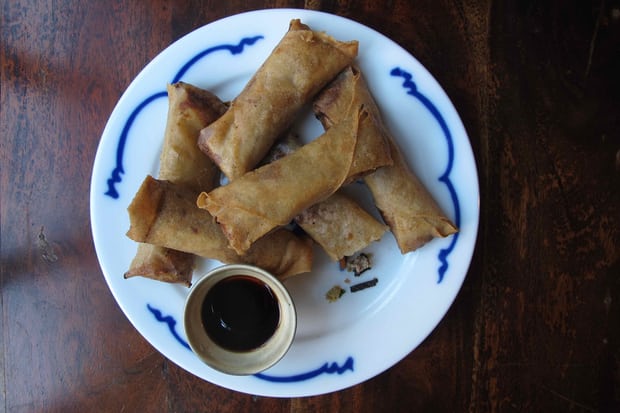
Perfect and ready to eat as soon as they're ready. Photograph: Felicity Cloake for the Guardian
Perfect spring rolls
(Makes 8)Drain the mushrooms, saving the soaking water, and roughly chop.
Heat the oil in a frying pan and cook the ginger and garlic for a minute, then stir in the five spice. Stir-fry for 30 seconds, then add the vegetables, mushrooms and about two tablespoons of the mushroom water. Cook, uncovered, until the water has evaporated and the vegetables have softened. Stir in the oyster and soy sauce and the sesame oil and cook for another minute, then allow to cool. Stir in the pork and chives once completely cool (I find it easiest to squidge it together with my hands).
Lay a wrapper, one corner facing you, on a clean work surface and cover the remaining pile with a damp cloth. Have a bowl of cold water within reach. Put two teaspoons of filling in an oblong just below the middle, leaving a gap at each end, and then fold the bottom point over the top of the filling. Roll it up to the middle of the sheet, then fold the sides in over the top, wetting them slightly so they stick. Wet the top point, then roll up tightly. Repeat with the remaining wrappers and filling.
Heat a wok or large pan a third full of neutral oil to 180C/355F, or until tiny bubbles gather around a dipped chopstick. Fry the spring rolls in batches of three or four, for about five minutes each, turning occasionally, until golden and crisp. Drain on kitchen paper and serve hot with black vinegar and chilli oil, sweet chilli sauce, or Worcestershire sauce.
Spring rolls: what's your favourite filling? And, if you're celebrating Chinese New Year this week, what else will you be eating and drinking?